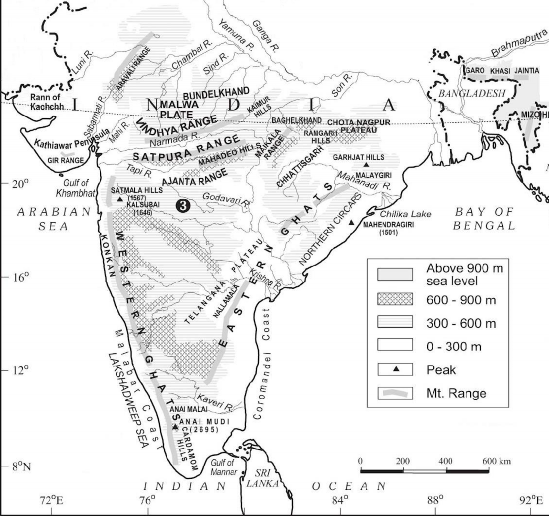3.3. The Peninsular Plateau
The Great Peninsular plateau is a tableland composed of the old crystalline, igneous and metamorphic rocks. It lies to the South of the Great Northern Plains. It covers an area of about 16 lakh square km, i.e., about half of the total area of the country. It is an irregular triangle rising from the height of 150 m above the river plains up to an elevation of 600-900 m. Delhi ridge in the northwest, (extension of Aravalis), the Rajmahal hills in the east, Gir range in the west and the Cardamom hills in the south constitute the outer extent of the peninsular plateau. However, an extension of this is also seen in the northeast, in the form of Shillong and Karbi- Anglong plateau separated from Peninsular by Malda fault. One of the distinct features of the peninsular plateau is the black soil area known as Decean Trap. This is of volcanic origin hence the rocks are igneous. When Indian plate was moving over Reunion hotspot, basalt lava spread to form these igneous rocks. Actually these rocks have denuded over time and are responsible for the formation of black soil.
The Peninsular India is made up of a series of patland plateaus such as the Hazaribagh plateau, the Palamu plateau, the Ranchi plateau, the Malwa plateau, the Coimbatore plateau and the Karnataka plateau, etc. This is one of the oldest and the most stable landmass of India. The general elevation of the plateau is from the west to the east, which is also proved by the pattern of the flow of rivers. Rivers such as Krishna, Kaveri, Godavari, all rise from Western Ghats, makes delta in the Bay of Bengal side. Plateau has been subjected to large scale denudation. Its mountains are generally of relic type. Because of their old age, all the rivers have almost attained their base level and have built up broad and shallow valleys. Some of the important physiographic features of this region are tors, block mountains, rift valleys, spurs, bare rocky structures, series of hummocky hills and wall-like quartzite dykes offering natural sites for water storage.
This Peninsular plateau has undergone recurrent phases of upliftment and submergence accompanied by crustal faulting and fractures. These spatial variations have brought in elements of diversity in the relief of the peninsular plateau. The northwestern part of the plateau has a complex relief of ravines and gorges. The ravines of Chambal, Bhind and Morena are some of the well-known examples. On the basis of the prominent relief features, the peninsular plateau can be divided into three broad groups: (i) The Deccan Plateau; (ii) The Central Highlands; and (iii) The Northeastern Plateau.

